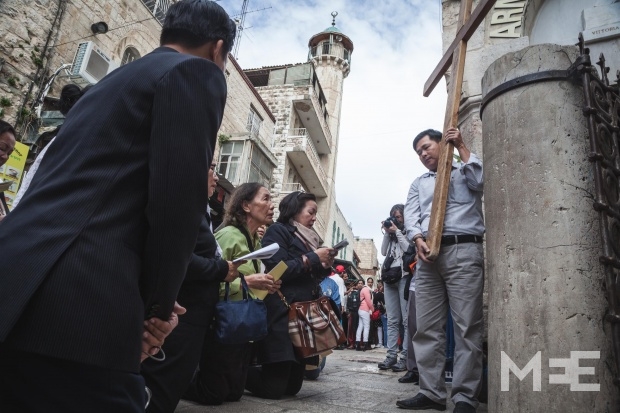Pilgrims celebrate Good Friday in Jerusalem

JERUSALEM - In the soft light of daybreak, small groups of Christian pilgrims gather to sing prayers in the courtyard of the Holy Sepulchre in the Old City of Jerusalem awaiting the church to open.
“It’s really nice to be in Jerusalem because we are Catholics and we wanted to be here and feel the whole environment of this day,” says Jesen, a Catholic from Honduras that scheduled his holiday around this particular day.
This is not just a regular Friday for the thousands of Christians that make the pilgrimage to Jerusalem. This is Good Friday, a Christian holiday to commemorate the crucifixion of Jesus Christ. Arguably the most important holiday in the Christian faith, thousands of pilgrims come from around the world every year to retrace Jesus’ steps upon the cobblestone and through the ancient alleyways of the Old City.
“It’s really great because there is a lot of people and a lot of different cultures involved,” says Jensen. “It’s a really different experience.”
Throughout the walls of the Old City, which is also home to the Dome of the Rock, the Al-Asqa Mosque and the Temple Mount thus holding particular importance to the world’s three major religions, the smell of incense perfumes the air.
Waves of Christian pilgrims make the procession along the Via Dolorosa - Latin for the “Way of Suffering”. They follow the path to each of the 14 stations that are important to the Christian faith, saying a prayer at each one before finally arriving at the ancient Church of the Holy Sepulchre. Tradition has it that the church was built on the site where Jesus was crucified, buried and resurrected.
Dorcas, a young woman from the Philippines, sings prayers in English just outside the entrance of the Holy Sepulchre. She says that she feels lucky to be able to be here on such an occasion. “We consider this the holiest place as we believe that everything happened here,” says Dorcas. “We are in the real place where the miracles happened.”
The crucifix is the symbol of the day. Thousands of crucifixes fill the small alleyways some held high proudly above pilgrims heads, some clutched intimately to one’s chest. Prayer beads, flowers, crosses and candles - a standard sight in the Old City - today completely saturate religious symbolism.
But this year, the conflict from last summer - “Operation Protective Edge” - still lingers closely in the minds of Jerusalem residents. “Here in the Via Dolarosa, we have bad business,” says David, a local shop owner who makes and sells his own crosses and prayer beads along the Via Dolarosa. “From last year until now, the tourists stay away. It’s not like a normal year.”
This year Good Friday and Easter Sunday closely aligned with the beginning of the Jewish holiday of Passover. Even with Operation Protective Edge’s lasting effects on incoming tourism, the Ministry of Tourism has declared they expect 130,000 visitors over the weekend alone.
But as the procession sweeps through the Old City, the turnout seemed particularly underwhelming. Although there are thousands of Christian pilgrims, curious passersby and tourists alike, the crowds in the alleyways are always moving, unlike the typical jam-packed hordes.
“We have heard from various locals and the convent that we are staying at that numbers are down. People are a little scared to come,” explains Angie, a Christian pilgrim from Canada. “I came alone. I’m here just on my own and I feel safe. There are beautiful people everywhere. If you go looking for trouble, you will find trouble.”
Stay informed with MEE's newsletters
Sign up to get the latest alerts, insights and analysis, starting with Turkey Unpacked
Middle East Eye delivers independent and unrivalled coverage and analysis of the Middle East, North Africa and beyond. To learn more about republishing this content and the associated fees, please fill out this form. More about MEE can be found here.

